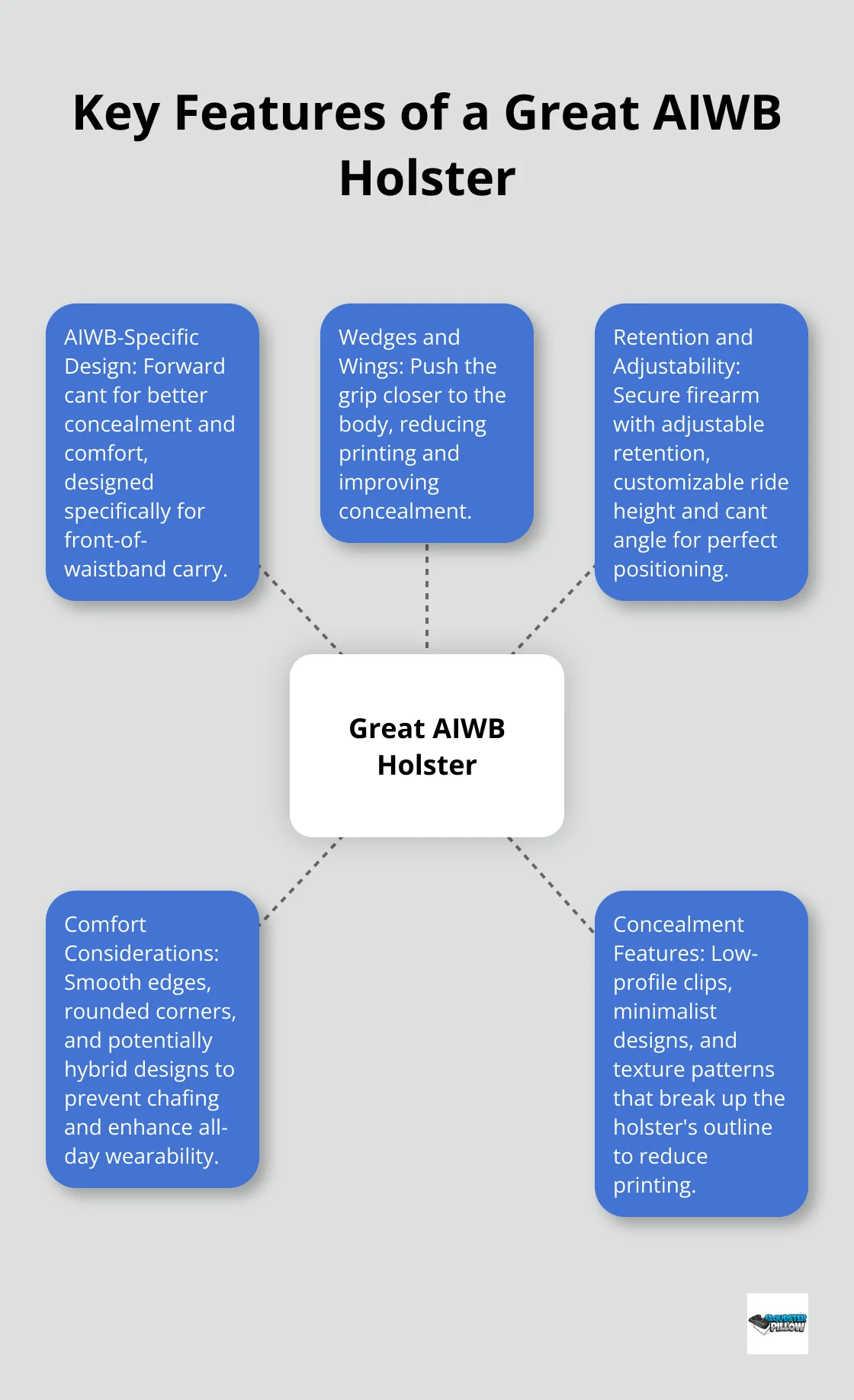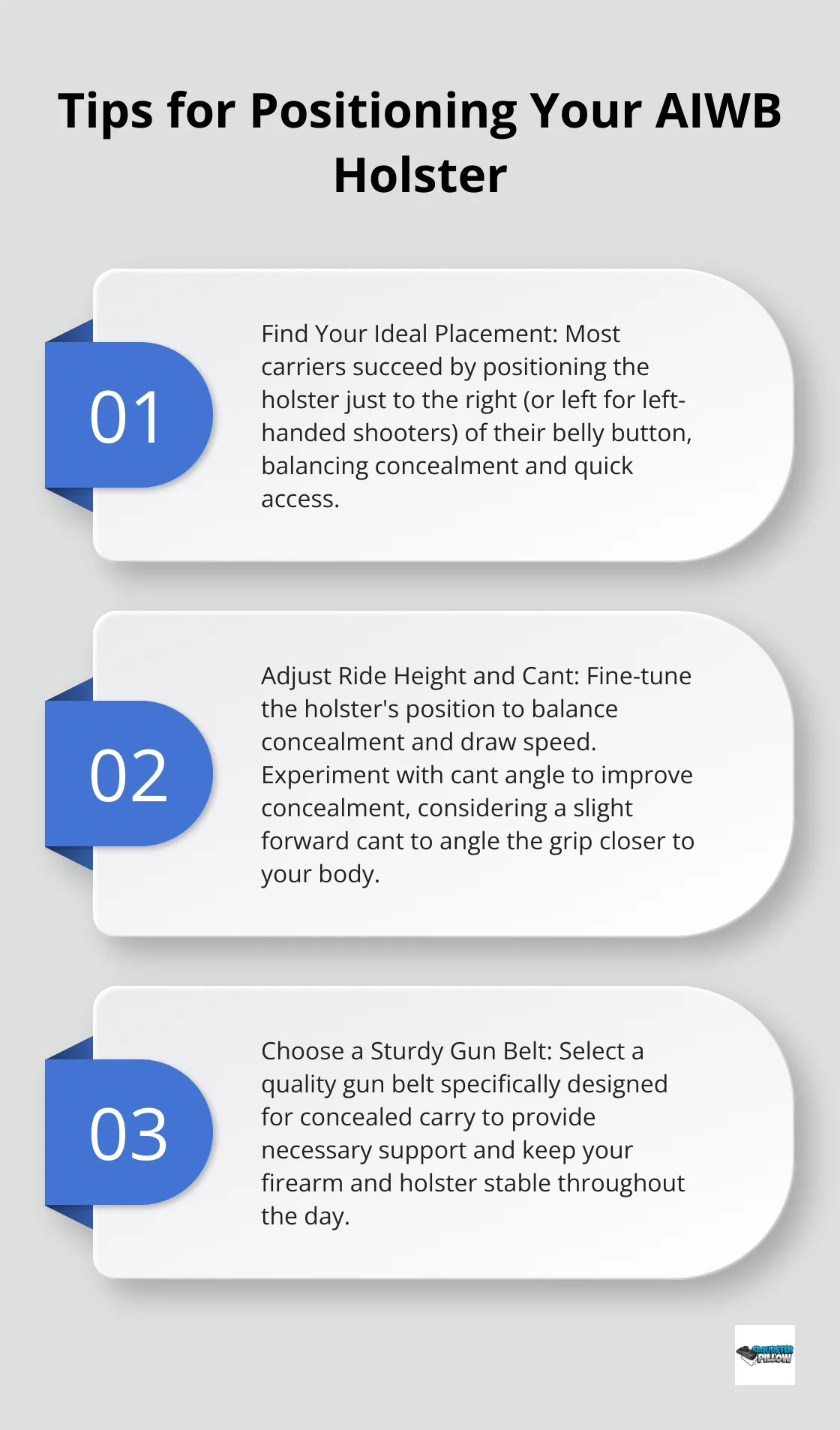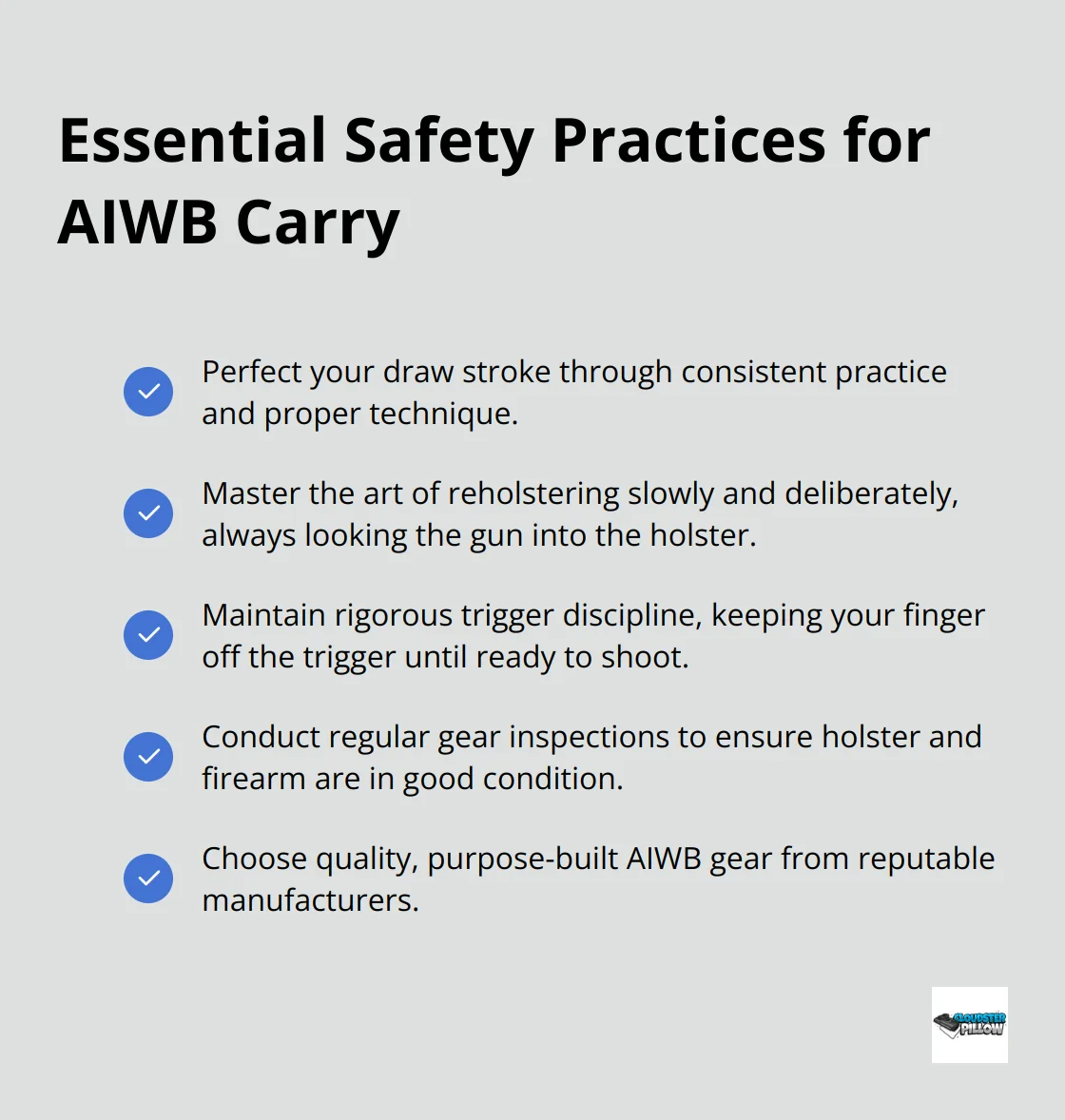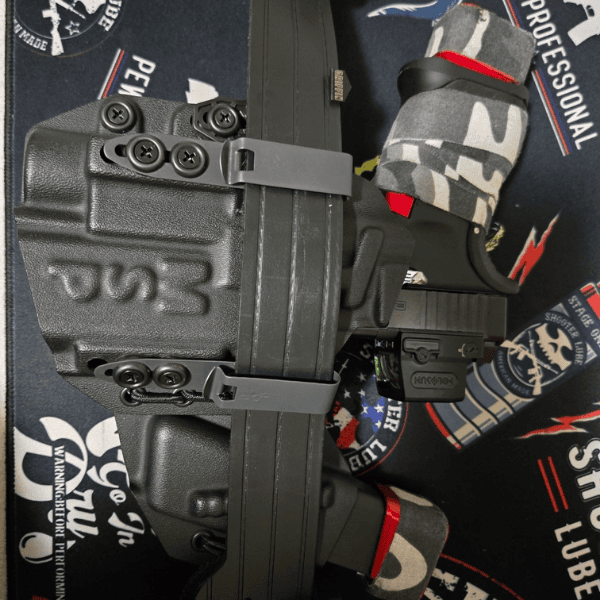Appendix Carry, AIWB
How to Master Appendix Carry: Essential Tips
At Cloudster Pillow, we understand the importance of mastering appendix carry for concealed carry enthusiasts. This carry method offers quick access and excellent concealment, but it requires proper technique and equipment.
In this guide, we’ll share essential tips to help you perfect your appendix carry skills, from choosing the right holster to ensuring safety and comfort. Whether you’re new to appendix carry or looking to refine your technique, these insights will boost your confidence and effectiveness.
What Makes a Great AIWB Holster?
AIWB-Specific Design
Appendix carry holsters are ideal for all-day concealed carry when designed with comfort features like padded backers and adjustable cant. A high-quality AIWB holster isn’t just a regular IWB holster worn at the appendix position. It’s specifically designed for front-of-the-waistband carry. Look for holsters with a forward cant, which angles the grip towards your body for better concealment. The Tenicor VELO4 exemplifies this design philosophy, offering superior concealment and comfort.
Wedges and Wings
Built-in wedges or wings transform AIWB carry. These features push the grip of your firearm closer to your body, reducing printing. While some holsters come with integrated wedges, many users find that adding a separate wedge (like the Cloudster Pillow) dramatically improves comfort and concealment for any CCW or EDC setup.

Retention and Adjustability
Your AIWB holster should keep your firearm secure while allowing for a smooth draw. Look for adjustable retention, typically achieved through tension screws. This allows you to fine-tune the holster’s grip on your firearm, ensuring a balance between security and accessibility.
Adjustability extends beyond retention. The ability to modify ride height and cant angle is essential for finding your perfect carry position. The Raven Concealment Eidolon excels in this area, offering extensive customization options.
Comfort Considerations
Comfort is paramount for everyday carry. Try holsters with smooth edges and rounded corners to prevent chafing. Some carriers prefer hybrid designs (combining Kydex and leather) for a balance of rigidity and comfort. The Hidden Hybrid Holsters offer this combination, but don’t forget to pair it with a Cloudster Pillow for optimal comfort.
Concealment Features
The best AIWB holsters incorporate design elements that enhance concealment. Features like low-profile clips, minimalist designs, and texture patterns that break up the holster’s outline can significantly reduce printing. The Tulster Oath, for example, boasts a thin profile that aids in concealment.
Now that we’ve covered the key features of a great AIWB holster, let’s move on to proper positioning and concealment techniques to maximize the effectiveness of your chosen holster.
How to Position Your AIWB Holster
Find Your Ideal Placement
The perfect position for your AIWB holster varies for each individual. Most carriers find success by placing their holster just to the right (or left for left-handed shooters) of their belly button. This location often provides the best balance of concealment and quick access.
Adjust Ride Height and Cant
Fine-tune your holster’s ride height to strike a balance between concealment and draw speed. A lower position can enhance concealment but might slow your draw. Conversely, a higher placement speeds up access but could increase printing. Many AIWB users prefer their firearm’s grip to sit just above their belt line.
Experiment with cant angle to improve concealment. A slight forward cant often angles the grip closer to your body, reducing visibility. Some holsters (like the Tenicor VELO4) come with a built-in forward cant. For holsters without this feature, adding a wedge can achieve a similar effect.

Choose a Sturdy Gun Belt
A quality gun belt is essential for effective appendix carry. It provides the necessary support to keep your firearm and holster stable throughout the day. Select belts specifically designed for concealed carry (e.g., Kore Essentials or Blue Alpha Gear). These options offer the right balance of rigidity and comfort, ensuring your setup remains secure even during physical activity.
Optimize Your Wardrobe
Your clothing choices play a significant role in successful appendix carry. Opt for loose-fitting shirts that drape over your firearm, breaking up its outline. Patterned shirts can further disrupt any printing. For pants, select a slightly higher rise to comfortably accommodate your holster.
In warmer weather, an undershirt can improve comfort by creating a barrier between your skin and the holster. It also helps wick away sweat, protecting your firearm from moisture.
Practice Natural Movements
Effective concealment isn’t just about hiding your firearm-it’s about doing so without drawing attention. Practice natural movements and avoid constantly adjusting or “checking” your concealed firearm in public. This habit can actually draw more attention to your carry setup.
Now that you’ve optimized your AIWB holster position and concealment strategies, it’s time to address a critical aspect of appendix carry: safety considerations. The next section will cover essential safety practices to ensure your AIWB setup is not only comfortable and concealed but also secure.
Mastering AIWB Safety
Perfect Your Draw Stroke
A smooth, safe draw requires consistent practice. Always triple-check that your firearm is unloaded before dry fire training. Focus on a fluid motion that clears your cover garment and establishes a full firing grip before the gun leaves the holster. Push the handgun down and then pull it upwards for the most efficient technique. This minimizes the risk of snagging or fumbling during high-stress situations.
Master the Art of Reholstering
Reholstering is where most negligent discharges occur with AIWB. Always look your gun into the holster, move slowly and deliberately. Clear your cover garment with your support hand, and use your thumb to feel for any obstructions as you insert the firearm. Never force the gun if you feel resistance – stop, reassess, and start over if needed.
Maintain Rigorous Trigger Discipline
With AIWB, your muzzle often points at sensitive areas. This makes trigger discipline absolutely critical. Keep your trigger finger straight and high on the frame until your sights are on target and you’ve decided to shoot. This habit should become automatic, even under stress.
Conduct Regular Gear Inspections
Your life may depend on your carry gear, so treat it accordingly. Inspect your holster daily for signs of wear, loose screws, or damage. Pay special attention to the trigger guard area – any compromise here could lead to a catastrophic failure. For firearms, follow the manufacturer’s maintenance schedule rigorously. A well-maintained gun is a reliable gun.
Choose Quality Gear
Not all holsters are created equal, especially for AIWB. Invest in a high-quality, purpose-built AIWB holster from reputable manufacturers. Cheap, poorly designed holsters can lead to safety issues and discomfort. Many AIWB carriers find that adding a wedge to their setup enhances both comfort and safety by improving the holster’s stability and angle.

FAQs
1. What makes a great AIWB holster for appendix carry?
A great AIWB holster is specifically designed for front-of-the-waistband carry. It features a forward cant to angle the grip towards the body, ensuring better concealment. High-quality AIWB holsters should also include built-in wedges or wings to push the firearm’s grip closer to the body, reducing printing and enhancing comfort.
2. How should I position my AIWB holster for optimal concealment and accessibility?
To find the best position for your AIWB holster, place it just to the right or left of your belly button, depending on whether you’re left or right-handed. Adjust the ride height and cant angle for the best balance of concealment and draw speed. Many users prefer the grip of the firearm to sit just above their belt line.
3. What role does a sturdy gun belt play in appendix carry?
A sturdy gun belt is crucial for appendix carry, as it provides the necessary support to keep your holster and firearm stable throughout the day. Choose belts specifically designed for concealed carry, such as those from Kore Essentials or Blue Alpha Gear. A quality belt prevents your holster from shifting, ensuring your setup remains secure, even during physical activities.
4. What safety practices should I follow when using appendix carry?
Safety in appendix carry is critical due to the firearm’s proximity to sensitive areas. Always maintain proper trigger discipline by keeping your finger off the trigger until you’re ready to shoot. Practice a smooth draw stroke and deliberate reholstering techniques to avoid mishandling. Regularly inspect your holster for wear and make sure your gear is always in good condition.
5. How can I enhance comfort and concealment with my AIWB setup?
To enhance comfort and concealment, consider adding a holster wedge to your AIWB setup. Wedges, such as the Cloudster Pillow, push the firearm’s grip closer to the body, reducing pressure points and improving concealment. Additionally, choosing a holster with smooth edges and rounded corners helps prevent discomfort, especially during extended wear.
Final Thoughts
Mastering appendix carry requires dedication, practice, and the right equipment. A purpose-built AIWB holster and sturdy gun belt form the foundation of your carry system. Many AIWB enthusiasts add a Cloudster Pillow to enhance comfort and concealment in their setup.
Regular practice perfects your draw stroke, safe reholstering techniques, and trigger discipline. These skills become second nature, allowing confident reactions in high-stress situations. Responsible carry extends beyond gear; stay informed about local laws and seek professional training.
Embrace the learning process and commit to improvement for enhanced personal security. Your dedication to appendix carry mastery will increase your confidence and peace of mind. Carry with assurance, knowing you’ve invested time and effort into this effective method of personal protection.


Pingback: Appendix Carry Tips for a Safe and Comfortable Experience - Cloudster Pillow
Pingback: What is the Best EDC Gun Belt for Concealed Carry in 2025? - Cloudster Pillow